Search the Special Collections and Archives Portal
Search Results
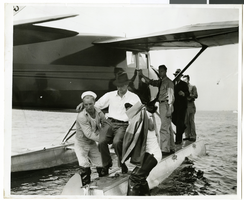
Photograph of Howard Hughes at a U.S. Coast Guard Station, January 15, 1938
Date
1938-01-15
Archival Collection
Description
Description printed on photograph's accompanying strip of paper: Howard Hughes being carried ashore after arrival in amphibian airplane at U.S. Coast Guard Station, Jamaica Bay, B.W.I.
Image
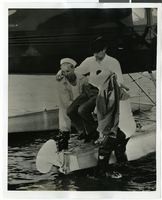
Photograph of Howard Hughes at a U.S. Coast Guard Station, January 15, 1938
Date
1938-01-15
Archival Collection
Description
Description printed on photograph's accompanying strip of paper: Howard Hughes being carried ashore after arrival in amphibian airplane at U.S. Coast Guard Station, Jamaica Bay, B.W.I.
Image
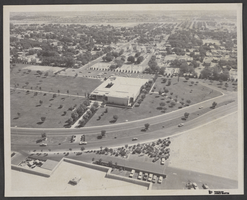
Aerial photograph of Civic Center Drive and North Las Vegas City Hall, May 23, 1970
Date
1905-05-23
Archival Collection
Description
An aerial view of the North Las Vegas City Hall and Civic Center Drive.
Image
North Las Vegas City Hall construction: digital photographs, 2010 October 04
Level of Description
File
Archival Collection
Bill Hughes Photographs
To request this item in person:
Collection Number: PH-00402
Collection Name: Bill Hughes Photographs
Box/Folder: Digital File 00
Collection Name: Bill Hughes Photographs
Box/Folder: Digital File 00
Archival Component
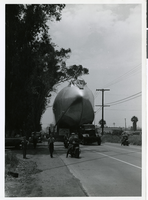
Photograph of a section of Hughes Flying Boat en route to the Los Angeles Harbor, June 15, 1946
Date
1946-06-15
Archival Collection
Description
A section of Howard Hughes' "Spruce Goose" or "Flying Boat" being moved (with a police escort) from the Hughes Aircraft plant in Culver City, California to Terminal Island in the Los Angeles Harbor where the plane was assembled in June of 1946.
Image
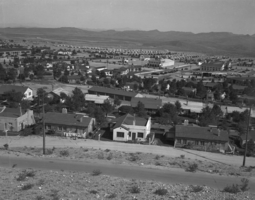
Film transparency of Boulder City, Nevada, December 15, 1933- June, 1934
Date
1933 to 1934
Archival Collection
Description
Panoramic view of houses from the water tank in Boulder City. This photo was taken between December 15, 1933 and June, 1934. Buildings that can be seen include City Hall (left), the Boulder Theater building (center), the Boulder Dam Hotel (right), and the Terminal Building with the Boulder Cafe (right).
Image

Savoy Restaurant menu, June 15, 1898
Date
1898-06-15
Archival Collection
Description
Note: Handwritten menu. "Déposé [registered] AD" [printer's monogram] printed under illustration on page 2. Illustration on page 2 shows a woman wearing a toga and sandals, with a raised wine glass and a scepter, riding atop a barrel being pulled by two oversized snails Restaurant: Savoy Restaurant
Text
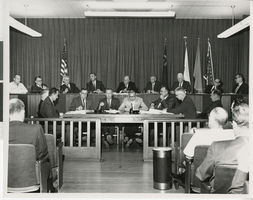
Photograph of a contract signing at City Hall, Las Vegas (Nev.), August 25, 1967
Date
1967-08-25
Archival Collection
Description
Signing of contracts for Lake Mead water pipeline at the Las Vegas City Hall. Sitting in the top row from left to right: unidentified individual, Arleigh West, Bureu of Reclamation, Oran Gragson, Mayor of Las Vegas, Paul Laxalt, Governor of Nevada, Robert Griffith, Chairman Colorado River Commission, William Taylor, Mayor of North Las Vegas, Leonard Fayle, President of Las Vegas Valley Water District, Mr. Hampton, Mayor of Henderson, Robert Broadbent, Mayor of Boulder City. Site Name: Clark County Court House, Las Vegas (Nev.)
Image
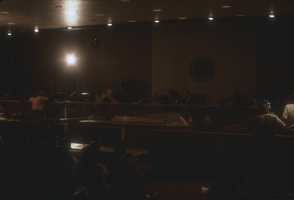
Unidentified individuals at a City Hall hearing in Las Vegas, Nevada: photographic slide
Date
1979-05
Archival Collection
Description
From the Sister Klaryta Antoszewska Photograph Collection (PH-00352).
Image
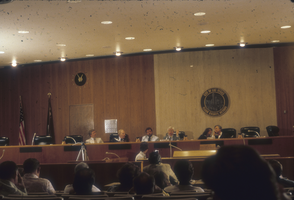
Unidentified individuals at a City Hall hearing in Las Vegas, Nevada: photographic slide
Date
1979-05
Archival Collection
Description
From the Sister Klaryta Antoszewska Photograph Collection (PH-00352).
Image
Pagination
Refine my results
Content Type
Creator or Contributor
Subject
Archival Collection
Digital Project
Resource Type
Year
Material Type
Place
Language
Records Classification
